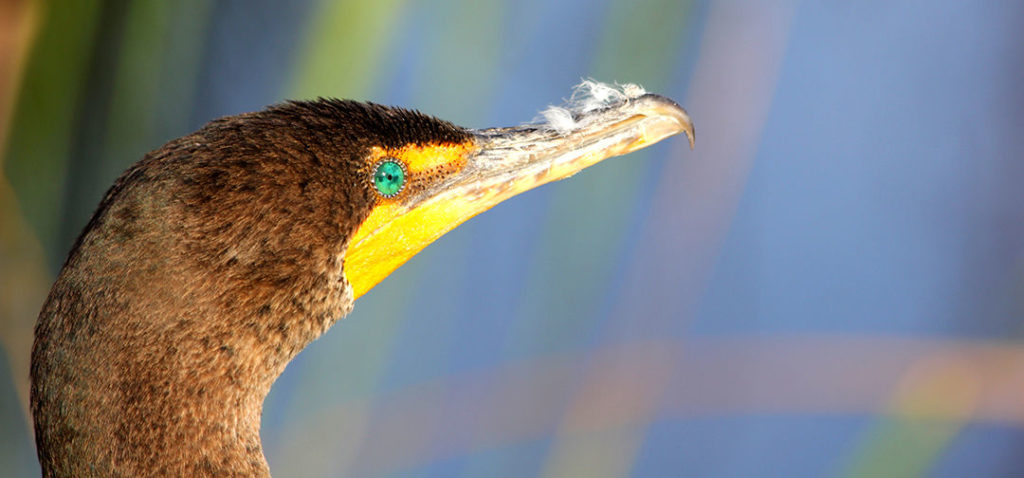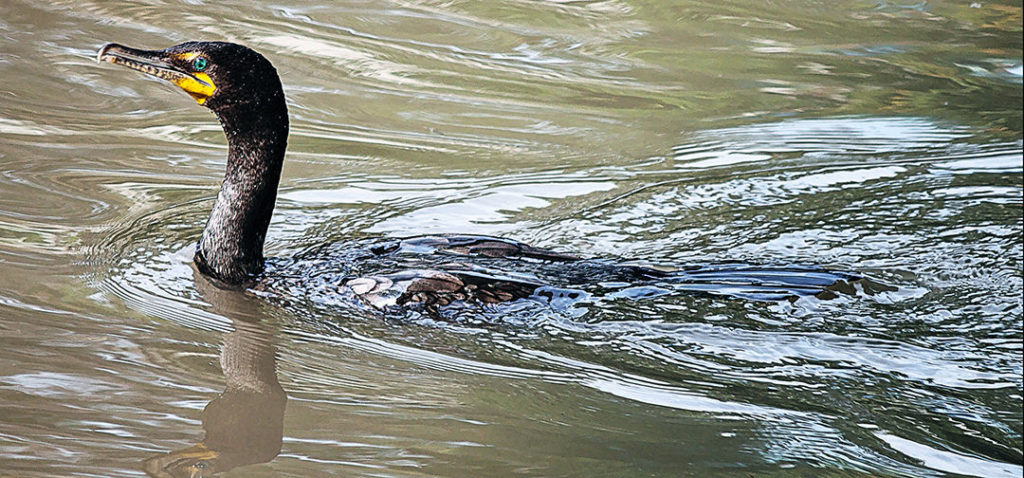Ontario Nature Blog
Receive email alerts about breaking conservation
and environmental news.
© Lora Denis
Double-crested cormorants © Larry Jordan CC BY-NC-SA 2.0
I was very disturbed to learn about a proposed provincial law, Bill 205, which has support from all parties. If passed, the bill will allow the indiscriminate hunting and trapping of double-crested cormorants, lifting their current protection under the Fish and Wildlife Conservation Act of 1997.
Here are three myths about cormorants that need busting before the government considers passing Bill 205.

1. Myth: Cormorants damage the fishing industry.
Reality: According to the Canadian Wildlife Service, less than two percent of a cormorant’s diet consists of sport fish. As Barry Kent McKay explains, “there is no empirical, scientifically determined indication that the fish consumed by cormorants have a significant, measureable negative impact on what is available to commercial and recreational anglers.” Cormorants are opportunity-based fishers – they eat what is most abundant and easily available which prevents them from depleting stocks of any one species.
2. Myth: The law needs to change to protect property owners.
Reality: Although it’s true that cormorants can cause damage to properties, the law already allows property owners to deal with this problem. Under the Fish and Wildlife Conservation Act, property owners may harass, capture or kill wildlife that is causing or is about to cause damage to their property.

3. Myth: There are too many cormorants.
Reality: DDT use dramatically decreased cormorant populations in the 1960s. When DDT was banned, they made a comeback. The recent rise in cormorant numbers is the result of a recovery from a previously precarious position. In fact, it appears that cormorant populations have plateaued in recent years. Yet, many people still think they are over-abundant.
The current law already addresses extenuating circumstances with cormorant populations. Culls have taken place to protect sensitive areas and heritage sites. This case-by-case approach is much safer than lifting protection entirely. It allows us to be sure that intervention is justified before we take action.
Humans have caused the natural world considerable harm over the years. Allowing the indiscriminate killing of cormorants won’t undo that harm. Non-human lives matter outside of measurable value to humans. Bill 205 ignores that completely.

Proposed 413 Route, Old School Road with farm and escarpment view © Noah Cole
Just want to dispel some myths about these new myths about cormorants. We are blessed to live in the absolute centre of a sport fishing haven. We are retired and are lucky to spend a great deal of time on our dock. Although I’m tiring of fishing, sadly we have a group of cormorants next door on a corporate property. These birds do absolutely nothing but kill sport fish all day every day. These birds eat all the small healthy fish, 3 to 4 inches in size they possibly can. Huge numbers of fish are eaten just before they can reach maturity. I am reading that they are a native species but of course I don’t remember them from my childhood. Anyway what I’m watching does not seem natural.
The main issue with them is destroying soils on shorelines due to their waste being so acidic. The other is bait fish populations although they may not eat sport fish directly per say they do however eat a ton of baitfish which could effect the fishing industry and sport fish. And lastly as a hunter I can assure you the hunting community will not be shooting the crazy limit of cormorants. Its not exactly the most edible bird so the appeal to hunt them just isn’t there however I’ve shot a few while duck hunting.But it’s not the slaughter people are making it out to be it’s a beautiful bird and the main reasoning behind this was to limit their damage to nesting/ shoreline habitat that many waterfowl and migratory birds need every year.
A group of golden cormorant type birds have been roosting in my South Dayton, Ohio area. They seem beautiful and calm. We don’t have fishing near here but lots of drainage ponds as the area is urban.
I am totally OK with the point being made in 1) above, but this statement just has BS written all over it:
“As Barry Kent McKay explains, “there is no empirical, scientifically determined indication that the fish consumed by cormorants have a significant, measureable [sic} negative impact on what is available to commercial and recreational anglers.””
That needs a reference. Most likely nobody has done any version of that study. If they did it would be footnoted. Barry is unknown to me, perhaps he has been doing such studies in every lake and river in Ontario, and has the best information known to science. What it looks like is a word salad that makes a claim about there being no scientific evidence to counter the preferred position because it has never been researched at all.
In the absence of evidence that there is such info, people adjoining waterways will draw their own conclusions from local observations.
The point needs to be better communicated. Because without that better communication one comes away thinking the people who made the point, not only don’t have a leg to stand on, or may be over-claiming.
2) Point 2) sounds reasonable, though not iron clad. It would depend on how much red tape there is to make a specific property affected cull. One would think that if this was available, people would not bother passing legislation.
3) 3) is a bit like 1). Assume cormorants were decimated, and are now back, given the decimation by DDT, why would we assume whatever number of cormorants have risen from decimation is perfectly in balance with the land. Is it Ontario Nature’s position that Ontario is a natural paradise in perfect balance? If it is not, how do we know the cormorants are in perfect balance?
Clearly some hunters are not playing by the rules. It appears that the commorant cull has already begun. While walking along the beach near the lift bridge in Hamilton we came across numerous dead cormorant. Who will clean up these rotting carcuses? Who is policing this cull?
Once the legal 108 day cull takes place mid September, one hunter is allowed to kiss 15 birds per day. There are approximately 200,000 hunters with a small game license across Ontario. Even if 10% of these hunters actively participate in the cull, we will see tens of millions of these dead birds.
Cororants eat very little native species choosing to feed on invasive non-native fish such as goldfish which have proven to be a real problem.
This is a high risk short sighted Ford Conservative Government policy that is not based on science.
When will we ever come to our senses and let nature takes its course and stop playing God?
Bob Heath I would be interested to know what exactly you “studied… for more than 45 years”. Cormorants “didn’t kill all the salmon fry” so what were you studying? In general…
Cormorants eat some many fish and have toxic feces.Stop their destruction.
I paddled my Kayak out around the docks of the old Lakeview Generating station (Mississauga, Ontario). I have never seen so many cormorants in one place…there were thousands of them.
I received this letter from the MP in my riding: Thank you for including our office in your correspondence, (with) regarding your concern on the proposed Cormorant cull. To provide clarification and context on this matter, our Government is taking action in response to the concerns expressed by our commercial fishing industry, property owners, and individuals that double-crested cormorants have had a negative impact on the environment. Specifically speaking, Cormorants eat a pound of fish per day and take over entire islands, disrupting the nests of other birds. Additionally, they are responsible for the loss of the only great blue heron colony on Lake Ontario, and a 56-percent decline in great egret nests in Lake Ontario, as well as the toxic effects of cormorant guano, which leads to deforestation and loss of vegetation in areas where they nest. The Ministry of Natural Resources and Forestry will review all comments submitted through the EBR posting before making a decision on the proposed hunt. If the proposed hunt proceeds, the Ministry will implement a population monitoring system, as we already do for other game animals.
Cormorants do eat a number of sportfish, but they also eat the small fish that all fish feed on. They certainly are not native to where I live, but the local lakes now have huge numbers of these birds, including an island that is dead from their nesting and droppings. They are an invasive species to my area.
Yes they are destructive, They kill all the salmon fry etc etc etc . They are everywhere. Trust me I studied them for more than 45 years. BRING THE CULLS ON!!
Human intervention is required, these birds are destroying nesting islands in Georgian Bay. This is an example where conservation must include a reduction in the number of these birds.
Cormorants are a nuisance steal fish out of set nets get tangled in the nets literally ruin peoples livelihood by ruining nets and stealing their food literally huge flocks of em causing a nuisance on a lake many fisherman and first nations people rely on
I’d love to take someone for a boat ride, especially in the hot days of summer, out of Sugarloaf Marina, in Port Colborne to the center of the west break-wall . There, everything is white from the cormorant feces and smells very bad when you go by. I’ve also seen it in other areas, like along the Niagara River and Kingston area, to name just a couple , where vegetation has been killed by them. I find it hard to believe that they don’t compete with fish for their food. I’m certainly not one for indiscriminate killing of any wildlife (one reason I belong to the Port Colborne and District Conservation Club), but in this case, I think culling is in order.
Simple observation at numerous locations around Hamilton Harbour will show that cormorants are eating numerous young-of-the-year sport fish that are struggling to make a comeback there. Last I checked, observation is a key step in the scientific method.
Your article reeks of disinformation.
Unfortunately we have made so many problems due to our own population explosion.the idea of live and let live has long been decimated. moose will be extinct in 50 years at present rate. do we allow wolf rates to increase hampering recover or moose ? please be open minded and put trust in science base knowledge .thank you to the MNR ground workers unfortunately they see very little of the 811 million budget for Ontario . sick of seeing money not going to were it matters!!
Although cormorants may not feed significantly on sport fish, they do feed heavily on other small fish which the sport fish depend on for food, thus impacting the sport fish as a result.
I will never understand or accept the rational that humans have the right or feel they have the privilege to decide the fate of other living beings. I think we have done enough to this planet and succeeded in the loss or decline of enough species. How disappointing and how sad for this species .